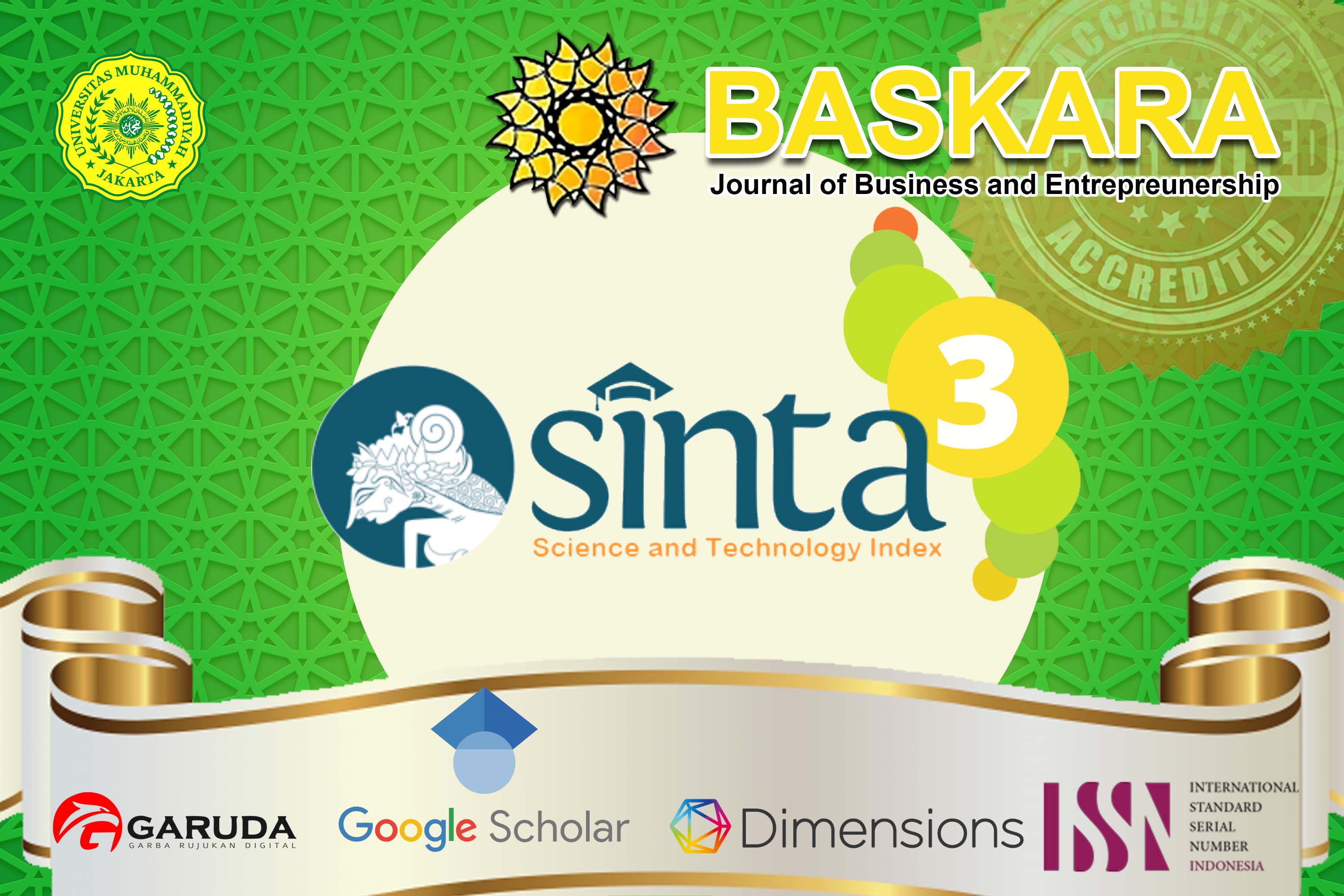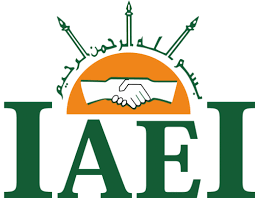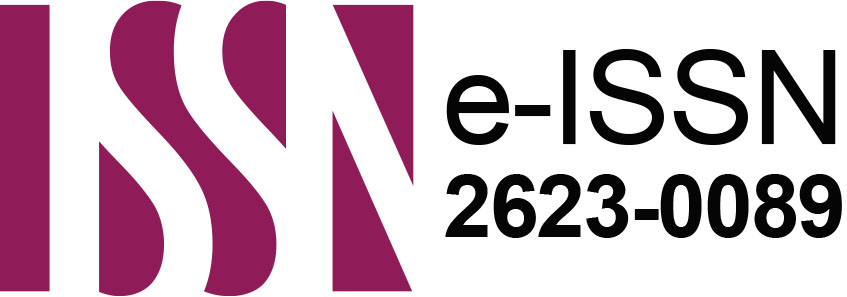Analysis of the Adoption of Digital Wallet Technology in Indonesian Society
Abstract
Keywords
Full Text:
PDFReferences
Agarwal, R., & Prasad, J. (1998). A conceptual and operational definition of personal innovativeness in the domain of information technology. Information Systems Research, 9(2), 204–215.
Agustian Wardana, A., Purwo Saputro, E., Wahyuddin, M., & Idris Abas, N. (2022). The Effect of Convenience, Perceived Ease of Use, and Perceived Usefulness on Intention to Use E-Wallet (Empirical Study on Generation Z in Surakarta). Advances in Economics, Business and Management Research, 218(Icoebs), 386–395.
Aji, H. M., Berakon, I., & Riza, A. F. (2020). The effects of subjective norm and knowledge about riba on intention to use e-money in Indonesia. Journal of Islamic Marketing, 12(6), 1180–1196. https://doi.org/10.1108/JIMA-10-2019-0203
Akinbobola, O. I., & Adeleke, A. A. (2013). The influence of user efficacy and expectation on actual system use. Interdisciplinary Journal of Information, Knowledge, and Management, 8, 43–57. https://doi.org/10.28945/1892
Amofah, O., Alex, O. A., Kwarteng, C. K., Bright, A., & Avorgah, S. K. M. (2023). Factors Influencing the Adoption of Digital Wallet: Evidence from Ghana. European Business & Management, 9(5), 101–111.
Ariffin, S. K., Abd Rahman, M. F. R., Muhammad, A. M., & Zhang, Q. (2021). Understanding the consumer’s intention to use the e-wallet services. Spanish Journal of Marketing - ESIC, 25(3), 446–461. https://doi.org/10.1108/SJME-07-2021-0138
Azizah, R., & Maghfirotun, K. (2023). The Value of Character Education in Surah Al-An’am Verses 151-153 A Comparison Study of Tafsir Al-Misbah and Interpretation of Al-Azhar. Rihlah Review: Jurnal Pendidikan Islam, 1(02), 89–98.
Bagla, R., & Sancheti, V. (2018). Gaps in customer satisfaction with digital wallets: challenge for sustainability. Journal of Management Development, 37. https://doi.org/10.1108/JMD-04-2017-0144
Bandura, A. (1998). Self-Efficacy. 1994, 1–65.
Bartoo, D. S. (2013). Financial Services Innovation: Opportunities for Transformation Through Facial Recognition and Digital Wallet Patents. 1–189.
Butar Butar, R. S., Dharmawan, D., Kalsum, U., Munizu, M., & Mertha Agung Durya, N. P. (2023). Application of User Experience Questionnaire Method to Evaluate Customer Experience When Conducting Transactions with Digital Wallets. Jurnal Informasi Dan Teknologi, 5(4), 210–215. https://doi.org/10.60083/jidt.v5i4.441
Chen, K., Chen, J. V, & Yen, D. C. (2011). Dimensions of self-efficacy in the study of smart phone acceptance. Computer Standards & Interfaces, 33(4), 422–431.
Choudrie, J., & Dwivedi, Y. K. (2005). Investigating the research approaches for examining technology adoption issues. Journal of Research Practice, 1(1), D1–D1.
Christina. (2017). Attitude, Subjective Norms, Perceived Behavior, Entrepreneurship Education and Self-efficacy toward Entrepreneurial Intention University Student in Indonesia. European Research Studies Journal, XX(Issue 2A), 475–495. https://doi.org/10.35808/ersj/654
Dash, G., & Paul, J. (2021). CB-SEM vs PLS-SEM methods for research in social sciences and technology forecasting. Technological Forecasting and Social Change, 173, 121092.
Davis, F. D. (1989a). Perceived usefulness, perceived ease of use, and user acceptance of information technology. MIS Quarterly, 319–340.
Davis, F. D. (1989b). Perceived usefulness, perceived ease of use, and user acceptance of information technology. MIS Quarterly: Management Information Systems, 13(3), 319–339. https://doi.org/10.2307/249008
Davis, F. D. (1993). User acceptance of information technology: system characteristics, user perceptions and behavioral impacts. International Journal of Man-Machine Studies, 38(3), 475–487.
Diong, I. H. W., & Toh, E. B. H. (2022). The Influences of Reference Groups Towards the Usage of E-Wallet Payment Systems. In Handbook of Research on Social Impacts of E-Payment and Blockchain Technology (pp. 428–455). IGI Global.
Do, N. B., & Do, H. N. T. (2020). An investigation of Generation Z’s Intention to use Electronic Wallet in Vietnam. Journal of Distribution Science, 18(10), 89–99. https://doi.org/10.15722/jds.18.10.202010.89
Edeh, E., Lo, W.-J., & Khojasteh, J. (2023). Review of Partial Least Squares Structural Equation Modeling (PLS-SEM) Using R: A Workbook. In Structural Equation Modeling: A Multidisciplinary Journal (Vol. 30, Issue 1). https://doi.org/10.1080/10705511.2022.2108813
Farida, I., & Ardiansyah, W. (2022). Technology Acceptance Model Factors: Implications on Digital-Wallet on Interest to Buy in Franchise Business. Golden Ratio of Marketing and Applied Psychology of Business, 2(2), 147–157. https://doi.org/10.52970/grmapb.v2i2.139
Finlay, K. A., Trafimow, D., & Moroi, E. (1999). The importance of subjective norms on intentions to perform health behaviors. Journal of Applied Social Psychology, 29(11), 2381–2393. https://doi.org/10.1111/j.1559-1816.1999.tb00116.x
Gautam, S., Kumar, U., & Agarwal, S. (2020). Study of consumer intentions on using mobile wallets using TAM Model. 2020 8th International Conference on Reliability, Infocom Technologies and Optimization (Trends and Future Directions)(ICRITO), 203–207.
Gefen, D. (2000). The Relative Importance of Perceived Ease of Use in IS Adoption : A Study of E-Commerce Adoption The Relative Importance of Perceived Ease of Use in IS Adoption : A Study of E-Commerce Adoption. 1(1). https://doi.org/10.17705/1jais.00008
Glock, C. Y., & Stark, R. (1970). Religion and society in tension: a publi. from the research program in the Sociology of Religion Survey Research Center, Univ. of Calif., Berkeley.
Gupta, A., Yousaf, A., & Mishra, A. (2020). How pre-adoption expectancies shape post-adoption continuance intentions: An extended expectation-confirmation model. International Journal of Information Management, 52, 102094.
Hair, J. F., Matthews, L. M., Matthews, R. L., & Sarstedt, M. (2017). Updated guidelines on which method to use. International Journal of Multivariate Data Analysis, 1(2), 107.
Hair Jr, J. F., Sarstedt, M., Hopkins, L., & Kuppelwieser, V. G. (2014). Partial least squares structural equation modeling (PLS-SEM): An emerging tool in business research. European Business Review, 26(2), 106–121.
Haji-Othman, Y., & Yusuff, M. S. S. (2022). Assessing Reliability and Validity of Attitude Construct Using Partial Least Squares Structural Equation Modeling (PLS-SEM). International Journal of Academic Research in Business and Social Sciences, 12(5), 378–385. https://doi.org/10.6007/ijarbss/v12-i5/13289
Hakim, A., Junaidi, E., & Laksmiwati, D. (2020). Characteristics of Flavanones from the Genus Artocarpus. Proceedings of the 2nd International Colloquium on Interdisciplinary Islamic Studies (ICIIS) in Conjunction with the 3rd International Conference on Quran and Hadith Studies (ICONQUHAS).
Harrigan, M., Feddema, K., Wang, S., Harrigan, P., & Diot, E. (2021). How trust leads to online purchase intention founded in perceived usefulness and peer communication. Journal of Consumer Behaviour, 20(5), 1297–1312. https://doi.org/10.1002/cb.1936
Hayati, N., & Kohari, K. (2021). THE DA’WAH CHALLENGE OF THE PROPHETS IN THE SURAT AL-ANBIYA’. Spektra: Jurnal Ilmu-Ilmu Sosial, 3(2), 1–25.
Heddle, N. M. (2002). Clinical research designs: quantitative studies. Vox Sanguinis, 83 Suppl 1, 247–250. https://doi.org/10.1111/j.1423-0410.2002.tb05312.x
Henseler, J., Ringle, C. M., & Sarstedt, M. (2015). A new criterion for assessing discriminant validity in variance-based structural equation modeling. Journal of the Academy of Marketing Science, 43, 115–135.
Ing, Y. I., Wong, T. K., & Lim, P. Y. (2021). Intention To Use E-Wallet Amongst the University Students in Klang Valley. International Journal Of Business And Economy, 3(1), 75–84.
Jameel, A. S., Rahman Ahmad, A., & Alheety, A. S. (2022). Behavioural Intention to Use e-Wallet: The Perspective of Security and Trust. 2022 2nd International Conference on Emerging Smart Technologies and Applications, ESmarTA 2022, October, 10–15. https://doi.org/10.1109/eSmarTA56775.2022.9935423
Jamilah, S., Ramadhan, Z., Yalina, N., & Nabighah, M. (2024). JEBIS : Jurnal Ekonomi dan Bisnis Islam TECHNOLOGY ADOPTION ANALYSIS OF. 10(2), 456–489. https://doi.org/10.20473/jebis.v10i2.65113
Johnson, B. R., Jang, S. J., Larson, D. B., & De Li, S. (2001). Does adolescent religious commitment matter? A reexamination of the effects of religiosity on delinquency. Journal of Research in Crime and Delinquency, 38(1), 22–44. https://doi.org/10.1177/0022427801038001002
King, W. R., & He, J. (2006). A meta-analysis of the technology acceptance model. Information and Management, 43(6), 740–755. https://doi.org/10.1016/j.im.2006.05.003
Koo, F., & Cuandra, F. (2022). Analysis of Factors Affecting International E-Wallet Use. Jurnal Bisnis Dan Akuntansi, 24(2), 337–352. https://doi.org/10.34208/jba.v24i2.1603
Kumar, A., Dhingra, S., Batra, V., & Purohit, H. (2020). A framework of mobile banking adoption in India. Journal of Open Innovation: Technology, Market, and Complexity, 6(2), 40.
Kusumastuti, R., Haryanto, R., Hidayati, U., & Wibowo, T. S. (2023). Security As a Moderation of Interest in Using a Digital Wallet With a Technology Acceptance Model (Tam). Jurnal Ekonomi, 12(3), 831–837. https://doi.org/10.54209/ekonomi.v12i3.2192
Lai, M. (2008). Technology readiness, internet self‐efficacy and computing experience of professional accounting students. Campus-Wide Information Systems, 25(1), 18–29.
Lakshmi, R. V., & Vaidyanathan, V. S. (2016). Journal of Statistics and Management Systems. Journal of Statistics and Management Systems, 19(1), 37–53. https://www.tandfonline.com/action/journalInformation?journalCode=tsms20
Lee, Y., Kozar, K. A., & Larsen, K. R. T. (2003). The Technology Acceptance Model: Past, Present, and Future. Communications of the Association for Information Systems, 12(December). https://doi.org/10.17705/1cais.01250
Lee, Y.-K., Park, J.-H., & Chung, N. (2009). An exploratory study on factors affecting usage intention toward mobile banking: A unified perspective using structural equation modeling. Society for Marketing Advances Proceedings, 347–359.
Lu, J. (2014). Lu, J. (2014). Are Personal Innovativeness and Social Influence Critical to Continue with Mobile Commerce? Internet Research, 24(2). Internet Research, 24(June).
Lutfillah, N. Q., Hapsari, A. P., & Candrawati, T. (2024). Determinants of Students’ Decisions to Use
Paylater Digital Financial Products. BASKARA : Journal of Business and Entrepreneurship, 7(1), 42–54. https://doi.org/10.54268/baskara.v7i1.23263
Masykur, M. A., Ikhwanuddin, M., & Prasetiawati, E. (2023). Reorientation of Al-Silm Kaffah QS Al-Baqarah [2]: 208 (Comparative Study of Tafsir Al-Jaila> ni and Tafsir Al-Mishba> h). Quality: Journal Of Education, Arabic And Islamic Studies, 1(2), 116–135.
Moorthy, K., Xiang, L. S., Govindarajo, N. S., & T, L. C. (2022). Issues and Perspectives in Business and Social Sciences A study of online grocery shopping behaviour in Malaysia. X(X).
Mushi, R. M. (2022). Impact of Normality Pressure on Acceptance of Mobile Phone Technology: A Case of Employees of SMEs. International Journal of ICT Research in Africa and the Middle East (IJICTRAME), 11(1), 1–11.
Nabila, M., Purwandari, B., Nazief, B. A. A., Chalid, D. A., Wibowo, S. S., & Solichah, I. (2018). Financial Technology Acceptance Factors of Electronic Wallet and Digital Cash in Indonesia. 2018 International Conference on Information Technology Systems and Innovation, ICITSI 2018 - Proceedings, October, 284–289. https://doi.org/10.1109/ICITSI.2018.8696091
Nadlifatin, R., Persada, S. F., Clarinda, M., Handiwibowo, G. A., Laksitowati, R. R., Prasetyo, Y. T., & Redi, A. A. N. P. (2022). Social media-based online entrepreneurship approach on millennials: A measurement of job pursuit intention on multi-level marketing. Procedia Computer Science, 197, 110–117.
Nag*, Dr. A. K., & Gilitwala, Dr. B. (2019a). E-Wallet- Factors Affecting Its Intention to Use. International Journal of Recent Technology and Engineering (IJRTE), 8(4), 3411–3415. https://doi.org/10.35940/ijrte.d6756.118419
Nag*, Dr. A. K., & Gilitwala, Dr. B. (2019b). E-Wallet- Factors Affecting Its Intention to Use. International Journal of Recent Technology and Engineering (IJRTE), 8(4), 3411–3415. https://doi.org/10.35940/ijrte.d6756.118419
Natakusumah, K., Maulina, E., Muftiadi, A., & Purnomo, M. (2023). Integrating religiosity into a technology acceptance model for the adoption of mobile payment technology. International Journal of Data and Network Science, 7(1), 305–312. https://doi.org/10.5267/j.ijdns.2022.10.003
Nguyen, O. T. (2020). Factors affecting the intention to use digital banking in Vietnam. The Journal of Asian Finance, Economics and Business, 7(3), 303–310.
Nur, T., & Joviando, J. (2021). Determination of E-wallet usage intention: extending the TAM model with self efficacy. 2021 3rd International Conference on Cybernetics and Intelligent System (ICORIS), 1–7.
Persico, D., Manca, S., & Pozzi, F. (2014). Adapting the technology acceptance model to evaluate the innovative potential of e-learning systems. Computers in Human Behavior, 30, 614–622.
Purbasari, L. T., Ratnasari, R. T., & Ab Rahman, A. (2023). Digital Wallet Adoption for Repeat Infaq Payment: Integrating Religiosity – Intention Model. Jurnal Syariah, 30(1), 34–75. https://doi.org/10.22452/syariah.vol30no1.2
Rahman, M., & Ariffin, S. (2022). THE INFLUENCING FACTORS AFFECTING CONSUMER’S INTENTION TO CONTINUOUS USE OF E-WALLET: A PROPOSED MODEL. Journal of Information System and Technology Management, 7, 85–98. https://doi.org/10.35631/JISTM.727007
Ramli, F. A. A., & Hamzah, M. I. (2021). Mobile payment and e-wallet adoption in emerging economies: A systematic literature review. Journal of Emerging Economies and Islamic Research, 9(2), 1. https://doi.org/10.24191/jeeir.v9i2.13617
Rathore, H. S. (2020). Adoption of Digital Wallet By Consumers. BVIMSR’s Journal of Management Research, 8(1), 69–75.
Rosli, M. S., Saleh, N. S., Md. Ali, A., & Abu Bakar, S. (2023). Factors Determining the Acceptance of E-Wallet among Gen Z from the Lens of the Extended Technology Acceptance Model. Sustainability (Switzerland), 15(7), 1–23. https://doi.org/10.3390/su15075752
Senali, M. G., Iranmanesh, M., Ismail, F. N., Rahim, N. F. A., Khoshkam, M., & Mirzaei, M. (2023). Determinants of Intention to Use e-Wallet: Personal Innovativeness and Propensity to Trust as Moderators. International Journal of Human-Computer Interaction, 39(12), 2361–2373. https://doi.org/10.1080/10447318.2022.2076309
Shah Alam, S., Mohd, R., & Hisham, B. (2011). Is religiosity an important determinant on Muslim consumer behaviour in Malaysia? Journal of Islamic Marketing, 2(1), 83–96.
Shih, Y.-Y., & Huang, S.-S. (2009). The actual usage of ERP systems: An extended technology acceptance perspective. Journal of Research and Practice in Information Technology, 41(3), 263–276.
Singh, S., & Ghatak, S. (2021). Investigating E-Wallet adoption in India: Extending the TAM model. International Journal of E-Business Research (IJEBR), 17(3), 1–13.
Singh, S., & Srivastava, R. K. (2018). Predicting the intention to use mobile banking in India. International Journal of Bank Marketing, 36(2), 357–378.
Straub, D., Limayem, M., & Karahanna-Evaristo, E. (1995). Measuring system usage: Implications for IS theory testing. Management Science, 41(8), 1328–1342.
Sukis Warningsih, N. M. (2021). Determining Factors of Digital Wallet Usage. Jurnal Manajemen, 25(2), 271. https://doi.org/10.24912/jm.v25i2.740
Supriadi, A. (2017). Integrating Qur’an and Science: Epistemology of Tafsir Ilmi in Indonesia. Jurnal Refleksi, 16(2), 149–186.
Suryati, S., & Yoga, I. (2021). the Influence of Perceived Ease of Use, Trust and Security on Intention To Use E-Wallet. Journal of Management and Islamic Finance, 1(2), 294–308. https://doi.org/10.22515/jmif.v1i2.4692
Susanti, L., & Alamsyah, D. P. (2022). Perceived ease of use as a precursor of mobile payment e-wallet. 2022 IEEE Zooming Innovation in Consumer Technologies Conference (ZINC), 123–127.
Teng, S., & Khong, K. W. (2021). Examining actual consumer usage of E-wallet: A case study of big data analytics. Computers in Human Behavior, 121, 106778.
Tikku, S. R., & Singh, A. K. (2023). Financial Disruption and Microentrepreneurs: Empirical Study on Adoption of E-Wallet Among Micro-Entrepreneurs in India. International Journal of E-Collaboration, 19(1), 1–14. https://doi.org/10.4018/IJeC.315780
Turner, M., Kitchenham, B., Brereton, P., Charters, S., & Budgen, D. (2010). Does the technology acceptance model predict actual use? A systematic literature review. Information and Software Technology, 52(5), 463–479. https://doi.org/10.1016/j.infsof.2009.11.005
Wilson, N., Keni, K., & Tan, P. H. P. (2021). The role of perceived usefulness and perceived ease-of-use toward satisfaction and trust which influence computer consumers’ loyalty in china. Gadjah Mada International Journal of Business, 23(3), 262–294. https://doi.org/10.22146/gamaijb.32106
Yang, M., Mamun, A. Al, Mohiuddin, M., Nawi, N. C., & Zainol, N. R. (2021). Cashless transactions: A study on intention and adoption of e-wallets. Sustainability, 13(2), 831.
Zhang, R. (2024). Subjective Norm , Self-Efficacy , and Policy Acceptance for Open Communication Science : An Empirical Analysis. 18, 3922–3944.
DOI: https://doi.org/10.54268/baskara.v7i2.26331
Refbacks
- There are currently no refbacks.
Copyright (c) 2025 BASKARA : Journal of Business and Entrepreneurship
BASKARA: Journal of Business and Entrepreneurship Copyright of Baskara: Journal of Business and Entrepreneurship (e-ISSN: 2623-0089 ). This work is licensed under a Creative Commons Attribution-NonCommercial 4.0 International License |
















